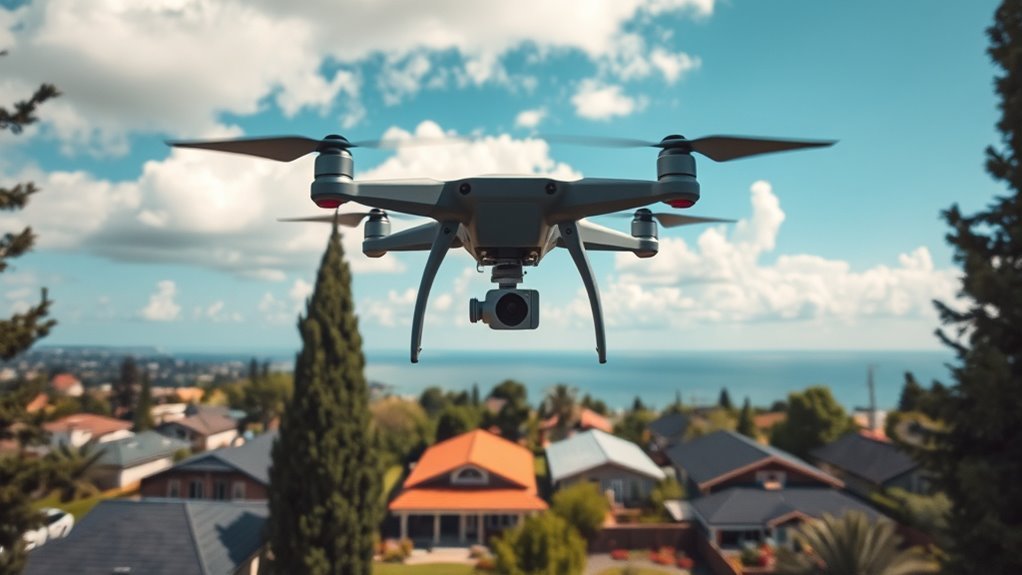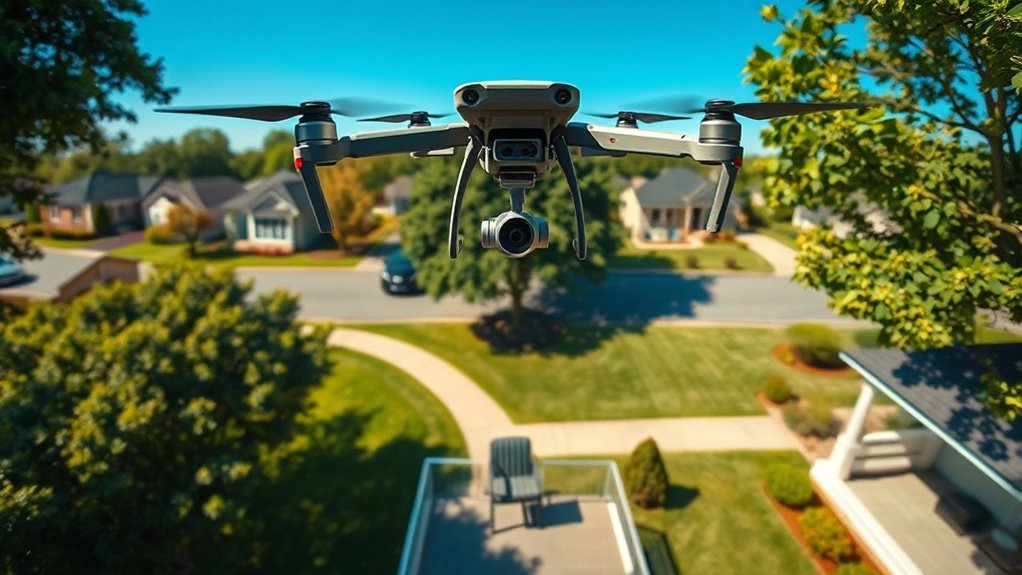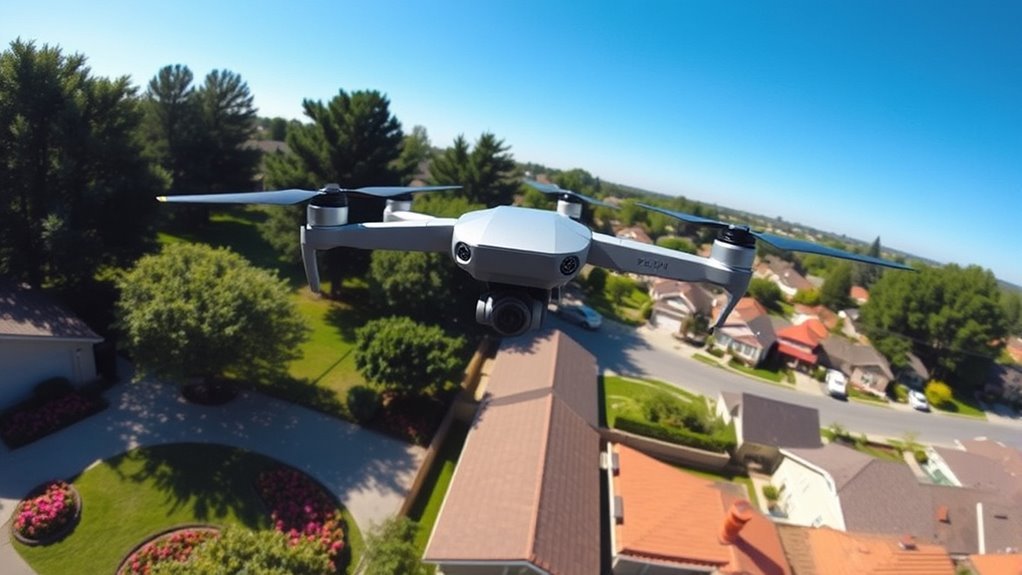Flying drones over private property isn’t strictly illegal, but it can fall under aerial trespass laws and privacy regulations. These laws vary by location and can hinge on the altitude of your flight and local ordinances. Understanding your rights and responsibilities is essential to avoid legal issues. If you’re unsure about specific regulations or potential conflicts with property owners, there’s more to take into account regarding airspace classifications and best practices for responsible flying.
Understanding Airspace Regulations

When you operate a drone, understanding airspace regulations is crucial, as these rules dictate where and how you can fly. Airspace classifications, from Class A to Class G, define specific zones and the corresponding restrictions. For instance, Class G airspace generally allows greater freedom for drone operations, while restricted airspace, often found near airports, imposes strict limitations. Familiarizing yourself with these airspace classifications guarantees you can navigate safely and legally. Additionally, certain drone zones may require permits or special notifications, especially in urban areas. By knowing the boundaries and requirements of each classification, you empower yourself to make informed decisions, thereby maximizing your flying experience while respecting the laws designed to promote safety and minimize conflicts with manned aircraft. Furthermore, understanding local regulations is essential to ensure compliance with specific flight rules in your area, particularly regarding no-fly zones that may apply in certain situations.
Federal Aviation Administration (FAA) Guidelines

Understanding the Federal Aviation Administration (FAA) guidelines is essential for anyone looking to operate a drone legally and safely. FAA regulations dictate how drones can be used, emphasizing the need for drone certification, especially for commercial operators. Familiarizing yourself with these rules will help you avoid legal issues and enhance your flying experience. Additionally, it’s important to remember that federal regulations supersede individual claims to airspace control. Furthermore, operators must be aware of specific restrictions regarding aerial photography to ensure compliance with privacy and safety laws.
| FAA Regulation | Requirement | Purpose |
|---|---|---|
| Registration | Must register drones | Guarantees accountability |
| Pilot Certification | Remote Pilot Certificate | Guarantees safe operation |
| Airspace Awareness | Understand airspace | Prevents conflicts |
State and Local Drone Laws

Although the FAA sets the groundwork for drone operation, state and local laws can vary considerably, impacting how you can use your drone in specific areas. State regulations often dictate where you can fly, with some states prohibiting drone use in certain locations or requiring permits for specific activities. Local ordinances can further complicate matters, as municipalities may establish their own rules regarding drone operation. This means you need to stay informed about both state and local laws to guarantee you’re compliant. Additionally, understanding restricted zones is crucial, as flying in these areas can lead to penalties or drone seizure. Ignoring these regulations could result in fines or even the confiscation of your drone. Always research your destination’s specific laws before flying to protect your rights and guarantee a smooth flying experience. Furthermore, being aware of signal penetration challenges can help you make informed decisions about where and how to operate your drone effectively.
Property Rights and Aerial Intrusion
Understanding property boundaries is essential when it comes to aerial intrusion, as the legal definition of airspace rights can greatly impact your privacy. Aerial trespass laws vary, and they often hinge on what you can reasonably expect regarding privacy above your property. As drone technology evolves, so do the implications for how your rights are protected in the airspace above your land.
Understanding Property Boundaries
Property boundaries play an essential role in the ongoing debate over aerial intrusion and drone usage. Understanding aerial boundary definitions is vital to navigate potential property line disputes. Here are four key points to take into account:
- Vertical Rights: You have rights extending above your property, yet the extent is often unclear.
- Airspace Usage: Drones flying at varying altitudes can challenge traditional notions of property boundaries.
- Local Laws: Regulations may differ by jurisdiction, impacting how aerial usage is treated.
- Neighbor Relations: Awareness of your neighbors’ perceptions can prevent conflicts and misunderstandings.
Recognizing these factors helps you navigate the complexities of drone operation while respecting others’ property rights. Ultimately, a balanced understanding promotes freedom in drone use without infringing on others’ domains.
Aerial Trespass Laws
Aerial trespass laws can be complex, often blurring the lines between property rights and drone usage. When you fly your drone, understanding the implications of aerial privacy is vital. If your drone hovers over someone’s property without permission, you might face trespass implications, even if you’re technically in public airspace. Courts have started recognizing that property owners possess certain rights above their land, creating a legal gray area for drone operators. It’s important to respect boundaries, as flying too low can be perceived as an invasion of privacy. Know that drone flights can lead to disputes; educating yourself on local laws will help you navigate these challenges while enjoying your freedom to fly responsibly.
Privacy Expectations in Airspace
While you might think that flying a drone in open airspace is free from legal concern, privacy expectations in that space are becoming increasingly nuanced. Understanding your airspace rights is vital, especially in the context of drone surveillance. Here are key considerations:
- Height Limitations: Generally, the law protects privacy within a certain vertical boundary above private property.
- Surveillance Intent: The purpose behind using a drone can shift the legal perspective on privacy intrusion.
- Public vs. Private Space: There’s a distinction between flying over public areas and private properties, affecting legal standing.
- State Laws: Different states have varying regulations regarding aerial intrusion, impacting your drone operation.
Navigating these complexities is essential to guarantee you respect privacy rights while exercising your freedom to fly.
Privacy Concerns Related to Drones
How do drones impact our sense of privacy in an increasingly connected world? The rise of drone surveillance poses significant challenges to personal privacy. As drones become more accessible, the potential for invasive monitoring grows. You might find yourself under scrutiny without even knowing it, as drones can capture images or videos from above, infringing on your private moments. This intrusion raises important questions about your rights to privacy in your own space. While regulations exist, they often lag behind technology, leaving many feeling vulnerable. As you navigate this evolving landscape, it’s essential to understand how drone usage can blur the lines between legitimate recreational use and privacy violations, emphasizing the need for a balanced approach that safeguards individual freedoms while respecting personal boundaries. Additionally, understanding federal laws protecting drones is crucial to recognizing the legal frameworks that govern drone surveillance and privacy issues. To address these concerns, geofencing technology has been implemented in drones to restrict flight paths and mitigate privacy risks.
Best Practices for Responsible Drone Flying
To guarantee responsible drone flying, you need to understand local regulations that govern airspace and drone usage. Respecting privacy boundaries is vital, as it helps maintain trust and prevents potential conflicts with those around you. Additionally, practicing safe operations will not only protect your equipment but also enhance the safety of others in the vicinity.
Understand Local Regulations
Understanding local regulations is essential for anyone looking to fly a drone responsibly, as these laws can vary considerably from one area to another. To guarantee you’re compliant, consider these points:
- Zoning Regulations: Check if your area has specific zoning laws that restrict drone usage in certain locations.
- Local Enforcement: Familiarize yourself with the local authorities responsible for enforcing drone regulations, as they can provide guidance.
- No-Fly Zones: Identify any designated no-fly zones, especially near airports, military bases, or crowded events.
- Flight Altitude Limits: Be aware of altitude restrictions to avoid infringing on airspace regulations.
Respect Privacy Boundaries
While flying a drone can be an exhilarating experience, it is crucial to respect the privacy of others to maintain a responsible flying practice. Drone etiquette dictates that you should avoid flying over private property without permission. This not only honors privacy rights but also fosters goodwill within your community. Be mindful of how your drone’s camera might infringe on others’ personal space, as even unintentional recordings can cause discomfort or concern. Before taking off, consider the potential impact of your flight on those below. Always prioritize transparency and communication with property owners when necessary. By being respectful and aware, you can enjoy the freedom of drone flying while ensuring that you uphold the privacy rights of others.
Practice Safe Operations
Guaranteeing safe operations is essential for any drone pilot, as neglecting safety protocols can lead to accidents and legal repercussions. To practice drone safety and engage in responsible flying, follow these guidelines:
- Pre-Flight Checks: Inspect your drone for any damage and guarantee all components are functional.
- Know the Rules: Familiarize yourself with local drone laws and regulations to avoid legal issues.
- Maintain Line of Sight: Always keep your drone within visual range to react promptly to any potential hazards.
- Avoid Crowded Areas: Steer clear of densely populated places to minimize risks to people and property.
Frequently Asked Questions
Can I Fly a Drone at Night Over Private Property?
Did you know that over 60% of drone enthusiasts fly at night? While it’s thrilling, night flying over private property can infringe on property rights, so check local laws before taking off.
What Are the Penalties for Violating Drone Laws?
If you violate drone laws, you’ll face various penalties. A penalties overview reveals legal consequences like fines, license suspension, or even criminal charges, depending on the severity of your infraction and local regulations. Stay informed to avoid issues.
Do I Need Insurance to Fly a Drone?
You might think you don’t need insurance for flying your drone, but having drone insurance offers essential liability coverage. It protects you against potential damages, ensuring your freedom to explore without financial worry.
How Can I Report a Drone Flying Illegally?
If you suspect a drone’s violating privacy, document its activity and gather evidence. Then, contact local authorities or the FAA to initiate the reporting process, ensuring you advocate for your rights while respecting regulations.
Are There Restrictions for Flying Drones Near Schools?
Soaring safely near school zones requires serious scrutiny. Drones often face distinct restrictions, ensuring drone safety for students. Always check local laws and regulations before flying to avoid unwanted confrontations or complications.

